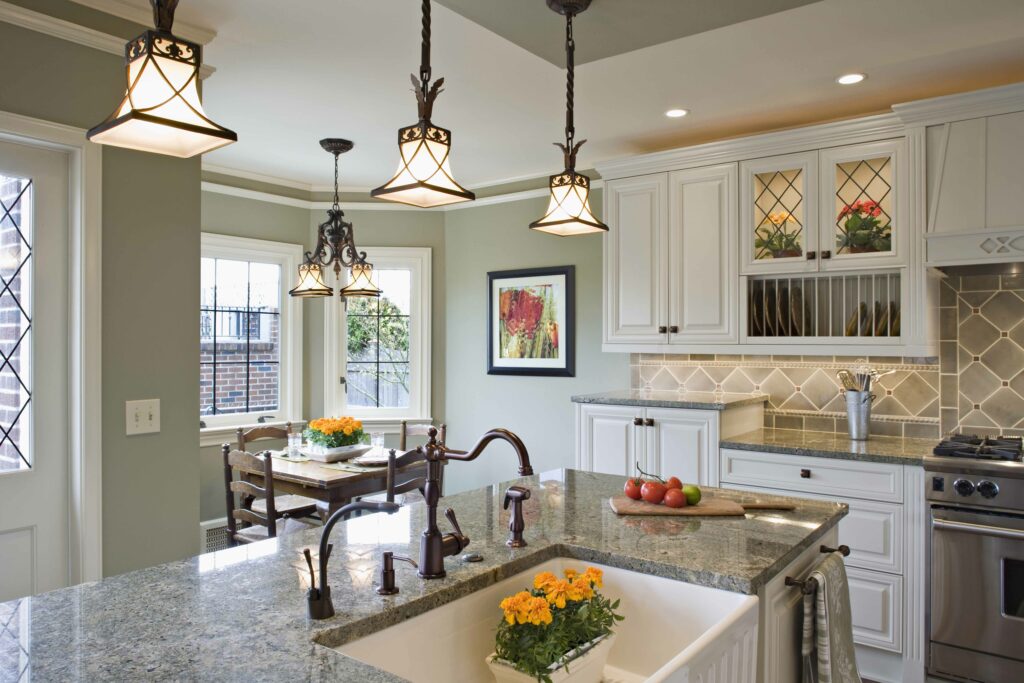
Here are some popular ways you can increase the value of your home:
Kitchen renovation: Making updates to the heart of your home, such as new countertops, cabinets, flooring, and appliances can greatly increase its appeal and value.
Bathroom remodeling: Updated bathrooms with modern fixtures, tiles, and amenities like a double vanity or walk-in shower can significantly enhance a home’s value.
Adding space: Increasing the square footage of a home, whether through room additions, finishing the basement or converting attic space, can boost its value, especially if it creates additional living areas or bedrooms.
Curb appeal: First impressions matter, so investing in landscaping, new siding, exterior painting or a well-maintained lawn can make a home more attractive to potential buyers.
Energy-efficient upgrades: Installing new windows, doors, and ENERGY STAR® appliances not only reduces utility costs but also adds value by making the home more appealing to environmentally conscious buyers.
Flooring updates: High-quality flooring, such as hardwood, laminate or tile, can add both aesthetic appeal and value to a home.
Smart home technology: Integrating smart home features like programmable thermostats, security systems, lighting, and entertainment systems can make a home more desirable to tech-savvy buyers.
Updating fixtures and finishes: Upgrading outdated fixtures, faucets, lighting, and hardware throughout the home can give it a more modern and cohesive look, increasing its value.
Structural repairs: Addressing any structural issues, such as foundation problems or roof repairs, is essential for maintaining or increasing a home’s value.
Additional amenities: Adding desirable amenities like a deck, patio or outdoor kitchen can make a home more appealing to buyers looking for extra entertainment spaces.
When planning home improvements for increased value, it’s essential to consider the preferences of potential buyers in your area and ensure that the upgrades are well-executed and in line with the overall style and quality of the home.
Projects that may not improve the value of a home

Swimming pools: A pool is more of an investment in your lifestyle than an investment in the value of your home. While some buyers may see a swimming pool as a desirable feature, they can also be seen as high maintenance and potentially dangerous, especially for families with young children. Adding a pool might yield a modest return, typically around a 7 percent increase in value. However, this assumption hinges on several factors: pools should be commonplace in your neighborhood, and the design should align with local preferences. Additionally, meticulous maintenance is crucial, and the pool shouldn’t take up the entire yard space.
Adding a sunroom: Building a sunroom is one of the most expensive projects and typically doesn’t yield the same return on the investment. Unlike a full-room addition, sunrooms are not often included in a home’s official square footage, which is a key factor that appraisers use to determine the value of a property.
Wall-to-wall carpeting: An increasing number of home buyers are turning away from this option. Carpeting is falling out of favor due to concerns about the chemicals used in its processing and its reputation as an allergy hazard. Investing in new carpeting in every room may not only fail to recoup its cost but could potentially lower the value of your home. Restoring or installing wood floors is a more preferable option.
Luxury upgrades in modest neighborhoods: Installing a gourmet kitchen or deluxe spa bathroom in a neighborhood where the majority of homes are more modestly appointed may not yield a significant increase in the value, as the market may not support the higher price.
Specialized rooms: A top-of-the-line media room outfitted with premium audio, visual and gaming equipment is undoubtedly a space your family can enjoy, and it might catch the eye of potential buyers. However, individuals who wouldn’t utilize it themselves wouldn’t be inclined to pay a premium for it.
Regular maintenance: Invisible improvements, such as a new HVAC unit and plumbing system, make your house a better place to live. Many home buyers, however, assume these systems are in good working order and will rarely pay extra just because they were recently installed.
Do-It-Yourself (DIY) projects with poor craftsmanship and inconsistent improvements: It’s essential that projects are done to a professional standard and maintain a cohesive look throughout the property.
Excessive customization: Custom features that cater to very specific needs or preferences, such as built-in aquariums or highly specialized storage solutions, may not add significant value if they limit the flexibility of the space for future buyers.
Extravagant-themed rooms: Highly personalized renovations may not appeal to a broad range of potential buyers and could even deter some.
Overdone landscaping: Elaborate and expensive features may not always provide a substantial return, especially if the maintenance requirements are high.
When considering home improvement projects, it’s essential to weigh the potential return on investment against the cost and effort involved, as well as the preferences of potential buyers in the local real estate market.


 Shared Branches & ATMs
Shared Branches & ATMs Apply for a Loan
Apply for a Loan Extra Awards
Extra Awards